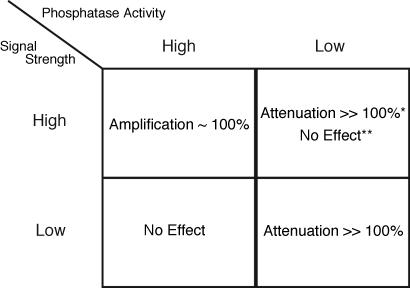Fig. 5.
Summary of different regimes that characterize scaffold-mediated signal transduction. The characterization of four regimes of scaffold-mediated signal transduction: (i) high signal strength and high phosphatase activity, (ii) high signal strength and low phosphatase activity, (iii) low signal strength and high phosphatase activity, and (iv) low signal strength and low phosphatase activity. * indicates the case when kinases bound to a scaffold cannot phosphorylate their downstream substrates that remain in solution. ** indicates the case when kinases can interact with their downstream targets that are present in the solution. The absence of * or ** indicates that the effect occurs regardless of whether scaffold bound proteins can activate downstream targets in solution. These results summarize our findings when phosphatases are allowed to act on scaffold-bound kinases and reflect the balance between stoichiometric constraints and removal of transport limitations by scaffolds. As described in Results and SI Fig. 9, preventing phosphatases from acting on scaffold-bound kinases does not alter these results substantially.

